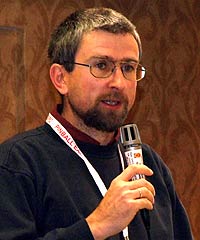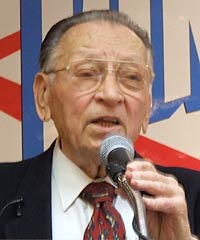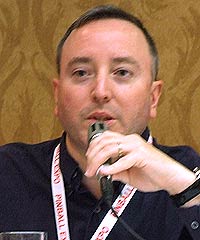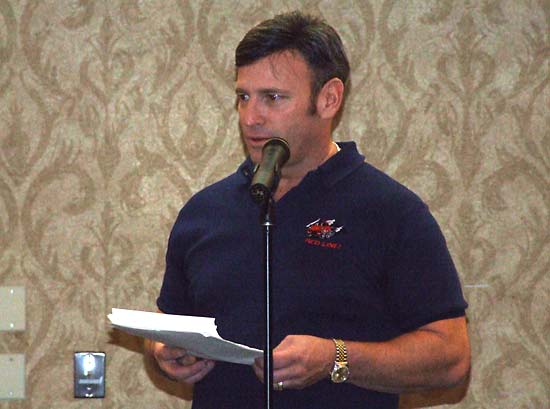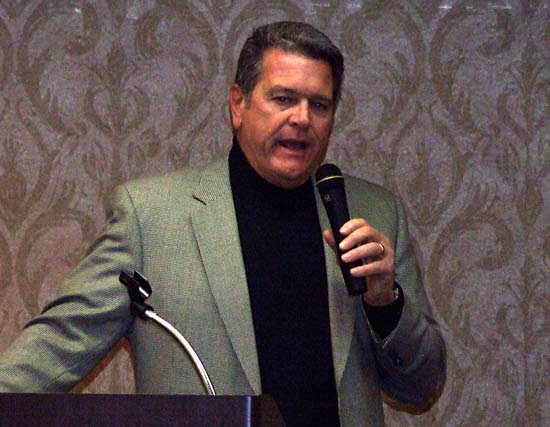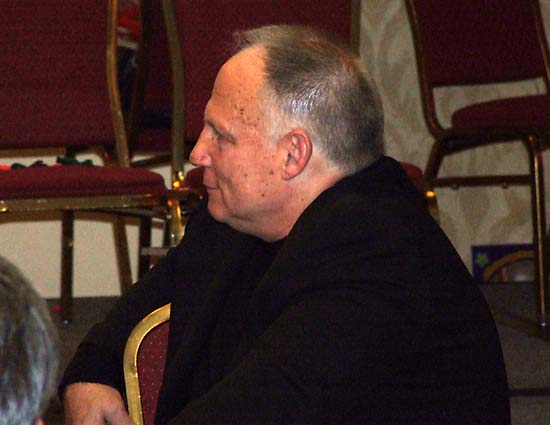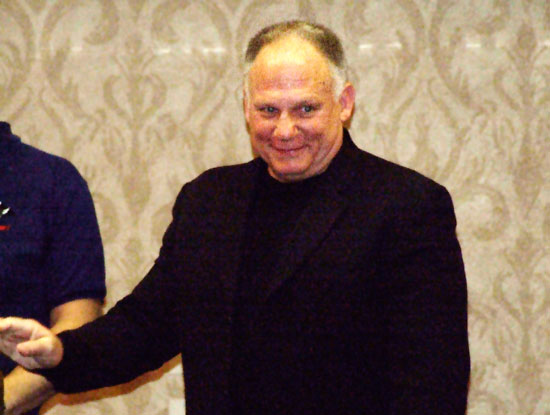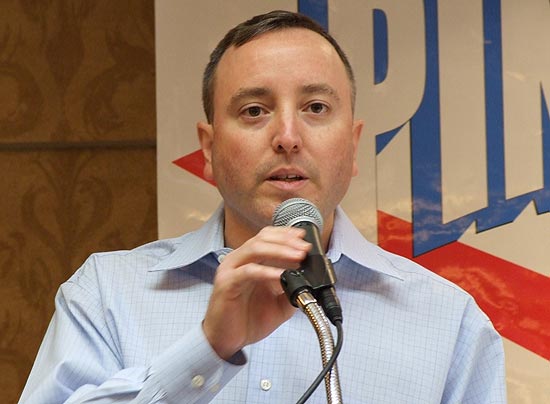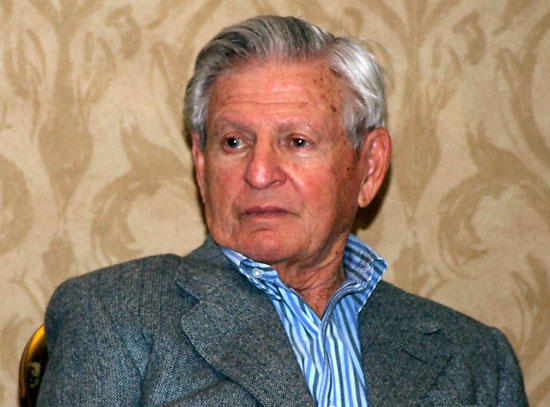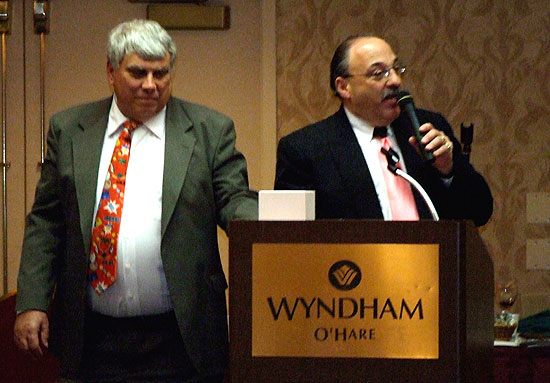
PINBALL EXPO 2006
| In a change from previous years, for Pinball Expo 2006 there were three seminars on Saturday morning. The Story Behind The 2006 European Pinball Championship - Martin Wiest As Pinball News readers will have seen, the 2006 EPC took place in Munich in April of this year. In this seminar Martin Wiest told the audience about the event, how it was planned, how the preparations went and how it all came together on the day.
His chance came in December of 2004 when the GPA, the Dutch Pinball Association and the Swedish Pinball Association came together with the formation of the EPC. This umbrella organisation was created to bring back an annual European tournament to be held in different countries each year. The first EPC took place in The Netherlands in 2005, next year it will be held in Sweden but it was in 2006 that it was in Germany. Planning began in the summer of 2005 when the location and dates were decided. It was to take place in Munich at the same location as the 2003 GPA event. Martin said it was difficult to find a suitable venue in Munich as most exhibition and conference halls are reserved far into the future. Having secured the location, the GPA paid the owners over $6,000 in the autumn of 2005. Meanwhile, planning for the machines had already begun in the summer months.
At the start of 2006 the web pages were set up and player registration could begin. The tournament rules were the subject of much discussion with some people advocating a knock-out system and others pushing for a points-based system. Finally the decision was made to reject the knock-out method and rank each player according to their score against all other scores on the same game. The groups were arranged to make sure they all played a good range of machines - Stern, Data East, early Williams, late Williams etc. That stage of the planning was competed by February 2006. It was also intended to run a Pinball 2000 tournament based around the system developed for Pinball Expo in 1999. The software for that tournament was written by several Williams employees in their spare time and it was found and enhanced with extra features for the EPC. In March 2006, Martin began collecting nearly 120 games from various locations to bring them to a central collection point ready for the trip to the venue. Martin supplied 48 games himself, with other individual collectors providing 25, 11, 9, 8 and 5 games from their respective collections. These were enough to fill six trucks. During April, Martin said he was spending every evening and weekend calling people and making the arrangements for the show at the end of the month. Then, finally, he took vacation from the 26th to the 1st of May so he could work on the show full time. In explaining the layout of the tournament games, Martin said there was a mistake in the planning because there was not enough room between the rows of games when all the players were gathered at the machines. This was an issue we highlighted in the Pinball News report. The EPC generated around $9,000 of income from visitors and vendors, while outgoings totaled about $10,000 but that difference is OK, said Martin, because it is the purpose of the German Pinball Association to hold events like this and funding is allocated to pay for them. The staff to run the event consisted of more than 50 people - from cashiers through to electricians and score inputers on the 11 PCs used. More than 500 visitors attended the event and of those, over 200 took part in the tournaments. Martin then related some of the problems he encountered in setting up and running the EPC. First of all, the space for car parking which had remained vacant for the previous twelve years, suddenly turned into a building site a week before the EPC, taking away 300 parking spaces. Inside, unknown to Martin, construction work was still taking place at the venue. It was scheduled to finish one day before the set-up of the show, but in practice the work overran and construction was still underway while the machines were being unloaded and set up for the tournament. Things were no better in other rooms. The dimly-lit kitchen was filthy from use by bands playing in the venue while the bathroom had no lighting at all and the heating was stuck on full blast. One of the main doors which was to be used to bring in the paletted early Bally solid state games had been converted to a wall but the biggest problem was caused by a safety inspector threatening to prevent the show taking place until the venue's owners made a number of changes to the building. A company was found to undertake the work and the show was given the go-ahead on Friday, less that 24 hours before the doors were opened to the public. After showing some pictures from the show, Martin talked about Hans Geiger and the conversions he produced of (mostly) early Bally solid state games for the German market. Hans had a stand at the EPC where he was selling his playfields and a good range of spares. The EPC also featured a team tournament with 10 countries represented including the USA who ended in second place. The eventual winners were the Hungarian team who were initially too late with their entry but the Spanish team dropped out at the last minute allowing the Hungarians to compete and then take the title. After describing the aftermath from the show, Martin explained how the EPC is now established as an annual event and after the 2007 show in Sweden, the following year it could be held either in Denmark or Italy as both countries have expressed an interest in hosting it. Next up to the podium was... The Story Behind Black Hole - Joe Cicak
Then he examined the invention of the Frisbee and showed how the idea came from the pies made by the Frisbie Baking Company and eaten by students at Yale and other New England colleges, who then used to throw the pie tins around as a recreational sport. The original name of the first commercial product was the Pluto Platter - intended to cash in on the growing popularity of UFOs with the American public - but was renamed the Frisbee after the original pie tins and the recreation's name of "Frisbie-ing". The next product Joe showed was the cheeseburger, without which - he said - there would never have been a Black Hole game. Joe was enjoying the aforementioned cheeseburger at the Brothers Brown restaurant in Harrisburg, PA when he noticed a technician working on a pinball machine. While the technician left the machine unattended for a moment, Joe went over to have a look and was surprised to find the large cabinet of the microprocessor-controlled game was mostly empty. He realised at that point there was enough space in the cabinet for another playfield. He returned to his cheeseburger to chew over both it and the idea, thinking how a lower playfield could slope in various directions if the upper playfield could be made of plexiglass or perhaps just make a window in the playfield instead. He had some design experience having created toys and furniture in the past but had no involvement with something as complicated as a pinball or other amusement games. Joe had no intention of taking the idea any further but that night he was at a friend's house where they were watching the Carl Sagan series Cosmos - A Personal Voyage, which was showing on TV back in 1980. In the programme, Carl was discussing black holes which were a recent hypothesis and much talked about. Joe mentioned his idea for a lower playfield and a see-through upper playfield and his friends talked about a number of ideas for the game including calling it Black Hole. They thought they could turn the idea into reality and decided to make one. Joe would design and build it, with his friends doing the marketing and all the other tasks needed to complete the project. After much work experimenting with different playfield designs and trying various components he came up with a workable layout which incorporated a window to reveal the lower playfield. The window proved problematic in several ways. Firstly, it restricted the number and positioning of the playfield components such as bumpers and drop targets but it also proved difficult to achieve a flush joint between the plexiglass and the wood so that the ball was not deflected when it crossed the boundary and didn't damage either material in the process. However, these issues were mostly overcome and so over the next 12 weeks, a proof-of-concept prototype machine was constructed.
He said it was a quite rough but most of the main elements were more-or-less unchanged on the final game including the tube from the lower playfield to the upper. It was a fully playable microprocessor-controlled prototype complete with game rules. There was a problem getting enough power to the ball kicker so it could get the ball all the way up the tube. Initial tests only got the ball part way up before it fell back. In a final attempt to fix the problem before pitching the game to Gottlieb, they connected the kicker solenoid directly to the 120V mains supply instead of the lower power solenoid supply. The result was a ball flying up the tube, out of the game and through the window. During the design process Joe said everything kept moving backwards to give the lower playfield more clearance. He tried making the entire upper playfield out of plexiglass to try to eliminate the problem of the window's seam deflecting the ball and the ball damaging either the wood or the window, but an entire plexiglass playfield is difficult to work with and any mistakes cannot be fixed as they can with wood. It was around the mid-point of the Black Hole design process when Williams brought out their first two-layer game Black Knight, putting pressure on other manufacturers to compete with their own innovative designs. They chose to show the game to Gottlieb because they were making the games with the biggest playfields and this game needed all the space it could get, said Joe. They finished the game around 3am and were flying up to Chicago at 5am to see the Gottlieb people. Gill Pollack took a look at it and showed it to some of the other people at the company who were excited about the game. They took the game, polished it up and made some changes to create the Black Hole game we know today. Joe said they did a great job with the final game and he especially liked the metal coil - which transports the ball from the top playfield to the lower one - and the artwork too. The prototype used a tinted plexiglass but the final game uses a blue colour which Joe thought worked much better. He wasn't so keen on the way the ball can be kicked up from the lower playfield and straight down the drain if the correct targets are not hit first, saying it was not part of the original design and was not something he was consulted about. Joe said he did get a few calls from the Gottlieb team during the game's development before it went out on test in September of 1981 but he thought there was a feeling of resentment within Gottlieb that a completely unknown team had come up with a game design and the company didn't acknowledge the concept had come from outside until years later. With Black Hole selling in excess of 8,700 units, Joe and his colleagues began work on their next game Dragon's Lair, based around the dungeons & dragons theme and going one better than Black Hole by being a three level game. The upper level was to be the mountains where the player collected special items to help on their quest down in the dragon's lair on the lower level. But then they found out Gottlieb had developed Haunted House so they stopped development on Dragon's Lair at the whitewood stage and went on to work on Critical Mass instead.
Joe explained the theme came from how the location for their game development was 3-4 miles away from the Three Mile Island nuclear reactor which was something very much in their thoughts. The aim of the game was to get the balls down into the lower playfield chamber which was surrounded by kickers and build up the feature towards critical mass. Balls were launched from under the game which led to a wider playfield as there was no shooter lane. Unfortunately, the timing of the project wasn't the best because Gottlieb were in the process of being sold to the Coca-Cola Company (and changing their name to Mylstar) who weren't interested in pinball but preferred to make video games instead. The previous animosity towards outside ideas and the lack of support for the pinball division from the parent company meant eventually the game was rejected and the project appeared to have ended at that point until it was resurrected by Eric Selak and friends, as seen at the White Rose Gameroom Show this year. After that, Joe went on to do some consultancy work for Ken Fedesna at Williams coming up with proposed designs for games but he said he came across the same resistance to external ideas as he found at Gottlieb. None of his designs ever made it to production but the closest was probably a game called Pinball Madness which was a pinball game based on pinball itself. Michael Gottlieb then spoke about the time his father had come back home from the factory and how he was excited about this new two level game he'd seen that day for the first time. He said the ball eject issue from the lower playfield to the upper playfield and then straight down the drain was done to cut back on ball time which was a problem with the initial design, and this was a quick and cheap way to solve the problem. He went on to say how after testing the game at a number of locations Gottlieb regularly used to evaluate their new models, Black Hole was easily the highest earning game they'd ever seen, bringing back players who were being drawn away to video games. Michael said, in particular, the animating backbox design with the infinity lighting was hugely attractive and a significant part of the game's success. Later though, the game was redesigned into a lower cost version called Eclipse without the lower playfield or the expensive backbox effects. Michael then spoke about the last months of Gottlieb under Colombia's ownership and in particular the prototype Krull game which also used a window to show a lower playfield but explained how the window was actually a fresnel lens to make the whole area look much smaller than it really was. Joe currently has two Black Hole games - he said he used to have three but he put one out on location at a health club and one time he went to collect the money and the game had been stolen. He said he only went ahead with the original Black Hole idea for fun and was surprised at the hard work and amount of knowledge he had to acquire about the design and build of pinball games in order to realise it.
Reminiscing with Steve and Michael - Steve Kordek and Michael Gottlieb Originally entitled "Reminiscing with Steve and Al", Alvin Gottlieb was unable to attend due to illness, so his son Michael stepped up to take his place alongside Steve Kordek.
Referring to the previous seminar, Steve said Gottlieb was one of the greatest companies in the world and when he was at Genco they used to copy many of the ideas coming out of Gottlieb. He recounted how Genco began with the three Gensburg brothers - Dave, Lou and Meyer - left Pittsburgh, PA and came to Chicago. Lou Gensburg came first and before long all three were distributing chocolate bars across the city. Soon after that they became involved in the amusement business and brought out their first game Harts in 1930 - a game designed by Harvey Heiss. Within a few years they were making pinball games and, Steve said, they did very, very well for many years. He stressed the correct pronunciation of the company's name as Genco (with a hard 'G', named after the Gensburg brothers) and NOT Jenco. The brothers also bought large areas of real estate which in the post-depression 1930s could be bought cheaply. The acquired hundreds of plots across the city - many consisting of corner stores with accommodation above - which rose sharply in value as the economy recovered.
When Steve joined Genco in 1937 the industry was in the transitional period while they moved from using batteries to power their games to using mains electricity. Steve's background in electrical engineering made him highly suited to pinball despite his lack of game experience. He said when Genco started producing mains-powered games they would get calls from their customers asking where they were supposed to plug in the games? Although mains power was becoming more and more popular, typical locations had very few electrical outlets and often none where the pinball game was situated. Michael then spoke about a time when his great uncle Sol was at a trade show and was demonstrating one of their new mains-powered games in a hotel room when suddenly smoke began rising from the mains outlet. While his great uncle was trying to desperately fan the smoke away and not draw attention to it, it transpired it was actually the hotel that was on fire and it was nothing to do with the game. Steve then spoke about Harvey Heiss, how he first met him and how he feels Harvey never received the recognition he deserved. Harvey used to spend much of his time on his beloved boat, even sleeping on it until he eventually got married. But even then the call of the water got to him and he returned to his boat more and more until his wife gave him an ultimatum - choose either the boat or me. Steve said it took Harvey about a month to decide but reluctantly he sold the boat and never saw it again. You can read more about Harvey in Steve's 2003 Expo seminar. Harvey taught Steve everything there was to know about designing pinball games - making them fun and making people want to play them again and again, he said. And did a lot of good for the company too. In January 1941, Steve got married and soon had a child on the way, but other events were to overshadow the end of that year. In November, Steve designed a game called Victory, just a month before Pearl Harbor and the start of the US involvement in World War 2. During the war, like most other manufacturing companies, Genco's production went largely into the war effort and because many of the raw material needed - such as copper for the coils and silver for the contacts - were unavailable, pinball production ceased for the duration of the war. Michael said Gottlieb were doing the same making parachute hooks but many people in the coin-op industry were busy trying to sell government war bonds as well as run their businesses.
Steve said Genco were unique amongst the pinball manufacturers because while everyone else was using AC for their solenoids and motors, Genco used exclusively DC which enabled them to do some tricks and add features not possible with AC. Genco games were selling so well, the company couldn't keep up with demand. They had three manufacturers making game cabinets for them but even that was not enough so each week an additional 80 cabinets were flown in from California. They came from a maker there who was using excess panels from Howard Hughes' H-4 Spruce Goose wooden airplane. Steve explained Genco's annuity plans which rewarded employees who stayed with the company. For those who remained with Genco for many years built up a sizeable pot to take with them when they either left or retired. Harvey, he said, went to North Miami and bought a double ranch home with his annuity. Steve, when he left to work at Bally and then Williams, used his money to get his kids through college which he said helped them tremendously. The Gensburg brothers went on to invest their earnings in the first high-rise casino in Las Vegas - the Riviera - which they subsequently bought out from the other investors and ran, until they sold it many years later to retire to California. Steve said the years he spent at Genco were some of the best years of his life. When the company eventually closed and he was available to any of the other pinball manufacturers, he insisted the other three members of his team all had to get jobs at whichever company took him on, and Bally were the only manufacturers willing to accept the whole team. A year and a half later, Steve accepted an offer from Sam Stern to join Williams and take over from Harry Mabs but the rest of his team stayed on at Bally until they all retired many years later. Harry retired to Hollywood, Florida while Steve took over and in 1961 alone designed nine games. The following year when he was the only designer at Williams, Steve designed ten games including Vagabond with the first ever drop target. In 1963 he produced another nine games but after that he teamed up with Norm Clarke which reduced the workload by alternating games between the two of them and gave Steve the chance to try some of the ideas he'd never had the time to try until then. To give some idea of the production runs and working practices in place at the time, Steve detailed how, when he first started at Williams, the production runs were only around 300-400 games. When the run was complete, the staff on the production line were sent home for a week or two until then next game was ready to roll, at which point they were called back in to start work again. It was only by the third year that production reached 1,000 games per run, from where it took off into the ten thousand level and above. Steve was asked about what it was like when he'd designed a game and it was being tested on location before it went into production. He said it wasn't exactly stressful because every game would be tested at the factory first. Ten test machines would be built and played day and night to identify any problems and ensure the play time and awards were set at suitable levels. Genco, like other manufacturers, had several test locations they used but by that time they knew more or less most of the results they would get back. The earnings relative to other recent games was the least predictable result and one they were most eager to discover. Michael said didn't think it was too stressful at Gottlieb either but he remembered a story about a pivotal moment at the factory involving designer Wayne Nyens. Over the years, management figures at Gottlieb - including Michael's father and grandfather - had become more comfortable coming into the engineering department to play the games in development and telling Wayne what they thought of them. Gradually their diverse and sometime opposite opinions grew into suggestions and then almost demands until on day David Gottlieb - Michael's grandfather - ordered everyone out of the engineering department and told Wayne very clearly, whatever Wayne wanted was the way it was going to be. After that, Michael said, the second guessing about what would be in the game disappeared, so Wayne knew he could do what he wanted to do and more times than not he was correct in his judgment calls. Steve concurred saying it was vital to have one person making the decisions about a game and in his experience that always led to the best result and the company making money. Steve Ritchie spoke from the audience to thank Steve for all the help, advice and assistance he had given him when he was getting started. Steve said he had been given advice by Harvey Heiss to make sure when training or assisting someone who was designing their game, not to be the main influence at the start of the game or to take the responsibility for making the game a success from the designer. They had to learn it was their responsibility to make or break the game. Michael said it was important to understand how Steve Kordek was probably the only person who successfully made the transition from electromechanical games to solid state. He said the genius of Steve was his ability to contribute to pinball for decade after decade, all the way from the time when the game was still using batteries through to Pinball 2000. Steve replied saying "You live, you learn" and "you only learn from people who are trying to learn themselves". And he said he never tried to take credit for what others accomplished or tried to do, which is very important in life. He'd seen so many innovations in pinball over the year, he said, but when he saw those six flippers on Humpty Dumpty it was a sight to see. He recounted the story of how Harvey had been ill and Steve had to step up to design a game for the January 1948 trade show. He'd seen the six flippers on Humpty Dumpty but had always been taught not to spend too much on a game, so put just two flippers in his game Triple Action and instead of being down the side like in Gottlieb's game, he put them at the bottom of the playfield, more or less where they've remained ever since. Steve said the introduction of the flipper was the single most important innovation in pinball's history. Once it had been invented, you couldn't sell, buy or operate a game without flippers and some of the early games were even modified to have flippers where none were intended. Michael talked about the transition from EM to SS games at Gottlieb. He said the new technology was not welcomed or embraced. In fact when Gottlieb contracted Rockwell to make the board set for the first solid state games, they simply gave Rockwell an EM game and told them to replicate it. He said his father Alvin was very concerned when solid state games were first introduced about the use of static and piezo lighters to rack up free credits and the need for industrial robustness since these machines were going out on location and being subjected to all kinds of abuse. Another problem was in less industrially developed countries where, even if you could find someone to repair a solid state game, parts were unavailable. Whereas electromechanical games were understood and parts were stocked. At this point the interpreter for Raymond Gay spoke from the audience to re-introduce Ray to Steve after many years. Ray worked to design the first solid state board system for Williams. Larry DeMar spoke from the audience to confirm Ray's contribution by laying out the circuit boards at Williams and Midway where Ray worked for 36 years and explaining how that process used to be a very manual one whereas today it's done with computers.
Ray then joined Steve in front of the audience which brought the seminar to a close.
Banquet featuring A 20-Year Salute To Gary Stern The Saturday evening banquet is the culmination of Pinball Expo. With the factory tour, all the seminars, the fireside chats, the exhibition halls, Pinbrawl and the tournament qualifying rounds all behind us, it a time to relax a little.
But the banquet has something of a checkered past. Earlier charges of providing poor food and the ingrained memories of the dismal 20th anniversary marathon have put some off attending - finding the local eateries a more attractive option instead. In all fairness, the banquet has improved since then, finding a better length and serving better food in a buffet format. This year's banquet was dedicated to Gary Stern and his 20 years of running a pinball company - first with Data East, then as Sega Pinball and now Stern Pinball Inc. It began as is customary with the Make-A-Wish auction where donated good were auctioned off to raise money for the children's charity. Goods included patches, signed flyers, posters, DVDs, signs, a Cactus Canyon playfield design, a jacket, a signed Steve Kordek t-shirt and finally an entire EM game. Rob Berk acted as auctioneer with Mike Pacak spotting bidders and assistance from Mark Bakula, Don Caldwell and Fred Young.
While some items went for small sums, others were mercilessly bid higher and higher, egged on by Rob. Larry DeMar paid $250 for a Steve Ritchie street sign, Kevin Steele of Gameroom Magazine bought a signed block of wood used by Mark and Don in their seminar and paid $150 for the chance to appear on the front cover of the Pingame Journal. In the evening's biggest show of largesse, a consortium led by Gary Stern paid an amazing $5,000 for an illuminated and signed Pirates Of The Caribbean translite.
After the auction, the meal was served from the buffet tables set up the the foyer outside. There was a selection of salad vegetables, cooked vegetables, pasta, meats and a number of deserts to choose from. Although in theory you could make a return visit, once everyone had taken their meal the buffet was cleared away fairly swiftly. Coffee and water were served at the diners' tables. The food was very similar to last year and of the same high standard making the $15 fee good value for a meal and the entertainment that followed. And that entertainment focused on guest speaker Joe Kaminkow's tribute to Gary Stern. Joe is Vice-President of Engineering and Game Development at gaming company IGT and a long time collaborator with Gary in setting up Data East Pinball and designing many of their games.
First of all, Joe asked for a few moments silence to remember Steve Kirk who died recently and he recounted his recent visit to see Ed Cebula who is seriously ill and wished he could be at the banquet that evening. Joe had brought with him a cabaret performer from Las Vegas, Russ Merlin. Russ is a comedy performance artist whose act involved taking members of the audience and generally making them look silly with magic tricks, sleight of hand and items from this props chest.
Russ then took four people from the audience, transforming them with the use of rubber masks and then getting them to perform in his comedy act.
Russ' act lasted 35 minutes after which Joe began his talk about Gary and their time together, illustrated with a number of pictures from the archives. Joe said they started Data East Pinball on 6th November 1986 having worked together at Game Plan. He, Gary and Shelley Sax were the founding three but others such as Mike O'Donnell and Don Thorne quickly joined so they could produce their first game Laser War by March the following year. He said they had so much quiet help in setting up the company with people rooting for them. Ed Cebula was one of those who helped fund the startup and remembered the time Gary was working with him at Game Plan and wired all the diodes in the prototype Loch Ness Monster back to front causing the game to blow up. They started the company in Gary's basement and presented their ideas to Konami, who turned them down. But it was Data East in the US who wanted to expand beyond video games and challenge the dominance of Williams and Bally. Joe remembers making the presentation to the company on the dining room table at Gary's former home. They moved into a condemned former gas company building with rats and dead birds for company. Laser War was designed on Thanksgiving Day in 1986. Joe said he designed it while watching football on a black and white TV and that design stuck with just the ball entry changed at Gary's suggestion that the game needed more on the playfield. Joe said with the company trying to get going it was quite remarkable because many people from other companies, such as Pat Lawlor, Larry DeMar and Eugene Jarvis all came over to help get the Data East up and running and as far as he is concerned, they were all founders too. He then showed a number of pictures from the company's early days.
Joe then showed Gary this flyer for their Secret Service game and asked if he knew what the significance was of the number 004412 in the bottom right corner:
It turned out this was an evidence number sticker from one of the many lawsuits they faced. After more pictures of Secret Service and Torpedo Alley, Joe came to this rare picture of the whitewood from Phantom Of The Opera.
After that came this picture of Gary at Hugh Hefner's Playboy Mansion when they made the 35th Anniversary game.
Other pictures shown included the Time Machine game and the Play Meter charts showing The Simpsons as number 1 in both the players' and operators' rankings. Joe then went through the subsequent games noting the significant points and people along with how they related to the company's fortunes at the time. Which brought us to the 10th anniversary.
Batman was the game at that time and Joe said he occasionally sees Jack Nicholson at the LA Lakers basketball game and checks to see if Jack's still got his Batman game, which he has. Joe then told the story behind this game:
There was an article in the trade press about a Korean game designer who was (supposedly) including electric shocks of the players in his games and killing them. Joe and Gary thought this was a cool idea and so just before a trade show they mocked up this game, put handle controls on it and left business cards around saying this designer was the new star at Data East pinball. Nobody played the game and it was just sitting there for three days, Joe said. Joe then read a tribute to Gary from Bob Gale, producer of the Back To The Future movies who praised Gary's tenacity, persistence and creativity. He revealed how their first ever dot matrix animation was "Push Start" and it was made by Jack Liddon who was known as King Jack at the company. In the final picture, he showed this trade advertisement created to celebrate the success of Jurassic Park.
Finally, Joe presented Gary with an engraved dual time zone watch for use on his many travels and this picture to hang on the wall of his office:
In reply, Gary thanked Joe and jokingly said pinballs were a by-product but he really does is eat for a living. Eating with suppliers and customers and people he works with, and he does it very well. In a more serious tone, he said they make pinballs first and foremost to make a living - as a business. They employ people, their suppliers employ people and they wouldn't have a factory full of people if the players weren't out there playing the games. He said they don't talk about Stern Pinball as the last man standing because that makes it sound like they're about to finish. Instead they say they're the only pinball company as they're not going to quit.
Gary said it's a very difficult thing they do at the factory. It's real manufacturing, he said, and that's what they do first and foremost. Some manufacturing friends of his from China came over and took a look at the factory with a view to setting up a second facility and said what goes on there is too hard for them to reproduce in their home country. It costs about $1m to produce a pinball machine, he said, and listed all the different job functions and areas needed to build a game and support it afterwards from the service department, human resources to accounting. And while they do it for a living, they also do it because they love pinball. He said they appreciate what the enthusiasts do for pinball but it's still a small part of the market - about 25% of their games go to the home market which he said is mainly 45 year old men, give or take a few years, who already have a pool table in their rec room, want a pinball and can convince their other half to let them buy one for the kids. Gary also recommended the Zizzle game if you have young ones, saying anything that helps promote pinball has to be good. But the main business has got to be operators, he said. Sometimes they design things and the enthusiasts might think they must be nuts, but all game design is trying to broaden the player base. He said Joe was doing that by having a large number of different models appealing to different sectors. Stern were trying to do the same with just one model at a time. Giving the slot machines in the UK as an example, he said the challenge was to keep the core players while trying to broaden the appeal to bring in new players. They don't always succeed and don't always get it right but that's what they're trying to achieve, he said. For pinball to continue to exist, it's got to be out on the streets, he continued. They're not really in the arcade business anymore, but in bars and bowling alleys now. He appealed to the audience to help keep pinball alive and to make sure they'll all be back in 10 or 20 years time by going out and playing pinball on location. Nobody else is going to get into the pinball business, he said. The economics just don't work no matter what anyone might want to see happen. So the only way to keep getting new pinball games is to find a game on location, go and play it and tell the location owner. Pinball is not a collector item, Gary said. It's a business expenditure to make the owner money, so get out of the home and go play. He concluded by thanking everyone for the evening and for the past 20 years.
The first time visitors to Pinball Expo were then asked to stand and were welcomed with a round of applause from the audience, followed by the same for those who have been to all 22 Expo shows. Awards was then given to Kevin McCarthy for traveling 1,000 miles from Colorado to bring 8.75 pinball games to Expo (eight full size games and the Cabin Fever TweenPin) for players to enjoy, and HSA Metal Plating to for the best exhibitor. Second place went to Playfield Renovations. A further award went to the winner of the Kids' art contest. Although there was only one entry this year it was of a high standard and deserving of the prize.
This gingerbread Medieval Madness as played by Santa Claus was made by Michelle Marseilles. (Apologies Michelle if the spelling of your surname is incorrect.) Next, Tom Nieman took to the podium to induct the newest member of the Pinball Expo Hall Of Fame.
Tom said three years ago he was was asked to come to Expo and talk about the good old days of pinball but instead was inducted himself. This year he got another call to come and make a presentation on behalf of the next recipient of the honour. Rather than waiting for the audience to try to guess who the inductee was, Tom announced it to be famed pinball artist Paul Faris.
Paul, he said, is someone we all know. He has been to many previous Expos and done the autograph sessions and, of course, seen his name on the backglass. But Tom said he knew Paul not only as a creative genius who brought to life so many great games at Bally, such as Xenon, Paragon and Centaur - games which were highly unconventional, took a risk and succeeded - but also as a mentor and motivator. He wasn't only hugely creative, said Tom, but he had the skills to manage and inspire a group of other diverse creatives in the art department at Bally. People like Greg Freres, Kevin O'Connor, Margaret Hudson, Dave Christensen and Pat McMahon. But beyond all that, Paul was an innovator, Tom continued. He was always looking for another, better way to do things such as the UV ink silk screening which gave Bally games a unique bright and vivid look so envied by their competitors and admired by the players. Tom said he also sees Paul as a collaborator and as a friend. When he was working on licensing deals for games such as Wizard, Kiss and Capt. Fantastic he would always seek Paul's opinions and advice. They would travel together to explore licences and investigate new ideas. He recalled the Bally game Playboy and how after signing the license with Christie Hefner they had a phone call from Hugh saying he had some ideas for the game he'd like to show them and could they possibly come down from Chicago to the Playboy Mansion? Tom and Paul wasted no time in making the trip, talked to Hugh who said, in order to get a real feel for the subject, he should show them around the place. Needless to say, the both had a great time and after their return found the need to make several return visits just to get everything spot on! With that tale, Tom and Joe formally inducted Paul into the Pinball Expo Hall Of Fame.
But Paul wasn't the only inductee this year, because during Friday morning's seminars, Michael Gottlieb took to the stage to introduce another new Hall Of Fame member.
Michael announced how, because the recipient of the honour wouldn't be able to attend Saturday's banquet, they were making the presentation to him now. He announced the next inductee into the Pinball Expo Hall Of Fame was Judd Weinberg.
Judd, he said, was important in pinball history because he spent the better part of his life running D. Gottlieb & Co as its President, in the process creating a huge number of memorable pinball machines. But the award, Michael said, was also for being such a great leader, husband, father and gentleman. Born in Chicago, he began work at his father's clothing company after graduating in 1947. Although his wife Marjorie Gottlieb was at Northwestern University at the same time as Judd, they didn't meet until they had both left campus. It was love at first sight, said Michael and within ten days of their first meeting, they were engaged to be married. Marjorie's father was David Gottlieb and he was delighted to have his son-in-law join the company D. Gottlieb & Co, which he did in 1952, quickly getting into the task of building pinball machines. Michael said it wasn't just pinball machines that his father Alvin Gottlieb, grandfather David and Judd built. They also built trust, integrity and honesty, knowing only one way to do business - the right way. He said respect is earned and being the son-in-law of the owner doesn't make it any easier. But Judd was smart. When working with Michael's father, Judd's skills perfectly complemented Alvin Gottlieb's. While Alvin was busy running the business side, Judd made sure the plan ran smoothly while taking time to talk with Wayne Nyens about game designs and new features such as add-a-ball. Judd saw huge opportunities for overseas sales and established a large global distributor network and making sure Gottlieb was the number one name on pinball across much of Europe. People talk about MBWA - management by waling around - but it's not a new idea, said Michael. David Gottlieb used to do it, as did Judd and dozens of employees fondly remember Judd as someone who knew the name of everyone on the floor of the plant. Under Judd's leadership, D Gottlieb prospered during the golden age of pinball and for decades they were at the top of their game. Michael spoke of the years Alvin spent building Gottlieb Memorial Hospital and when it was tough, he turned to Judd for help. In 1961 the 122 bed hospital in Melrose Park opened after the two of them turned a dream into reality and in the years that followed they have overseen its growth. Judd has always been a strong advocate of higher education and medical research. The latter he promotes through his support for work towards finding a cure for cancer while the former benefits from his years of work for Northwestern University. He also helped build two temples in the Chicago area. So, Michael said, we are here today to honour Judd who, while he is glad to be here to accept the award, he never imagined he would be someone who would make history, and the games being produced in the early '60s would become highly collectable and still enjoyed in the 2000s. In closing he quoted Wayne Nyens who said he could not imagine what would have happened to D Gottlieb and Co if Judd hadn't joined the company when he did. He was the driving force, understood business and was a good salesman too. He was unbelievable and did more for the company than anyone could have. And with that, Michael inducted his Uncle Judd into the Pinball Expo Hall Of Fame.
The banquet evening continued towards a timely conclusion with Rob thanking the staff of the Wyndham, his wife Brigitt and fellow Expo organiser Mike. Further thanks and awards went to Pinball News Editor, Martin Ayub for helping to sort out the audio and video equipment at the seminars, Dr Scott Sheridan and Ron Coon Jr for their help with the charity auction, to Mark Bakula and Don Caldwell for assisting at the auction and for building the lightbox for the Pirates Of The Caribbean translite that sold for $5,000 and to Fred Young for his help with the auction. Brian Matthews then came to the podium to award the prize for the best score on the UltraPin Medieval Madness game. The winner was Martin Ayub from Pinball News with a score of 173,872,210, which won him a Pinball Expo sweatshirt and bag. Jeff Mathews (no relation) then spoke and announced the winner of the Cabin Fever tournament. It was won by Isabella Gaureau who - although not present to collect it herself - would shortly receive a trophy to commemorate her win. Additional thanks went to Pingame Journal's Jim Schelberg for being the official show photographer and for agreeing to take part in the auction for the front cover slot won by Kevin Steele.
In conclusion Rob said it was great to see so many friends back at the Expo and it was like a reunion each year. He thanked Gary, Joe and Michael Gottlieb who, he said, had agreed to take part in next year's fireside chat. With that, the 22nd Pinball Expo banquet drew to a close.
© Pinball News 2006 |
